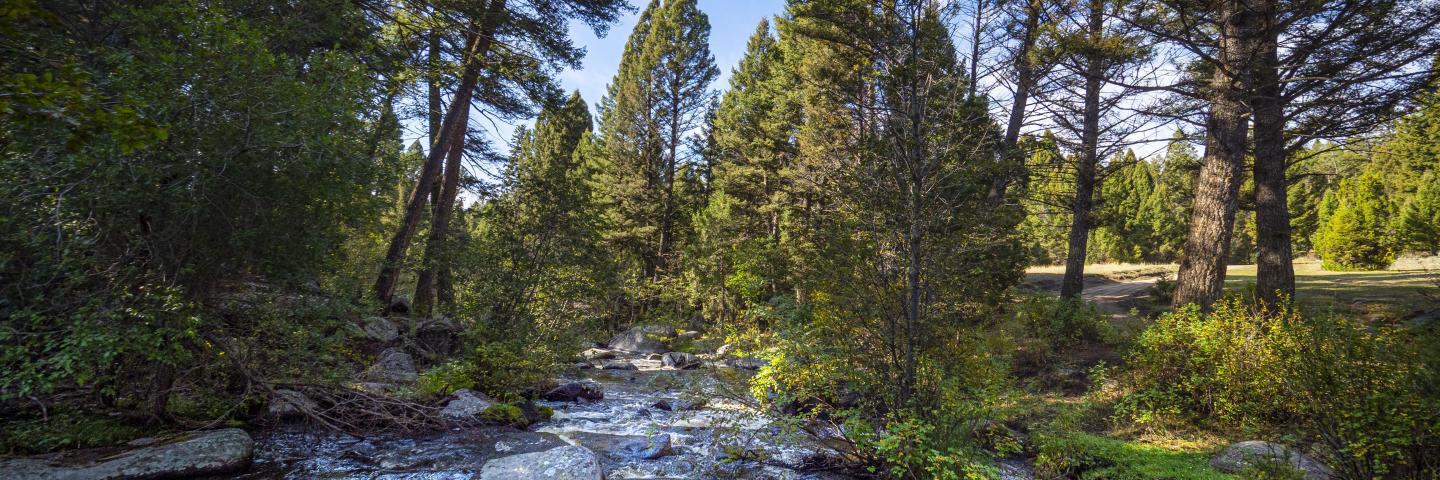
Forestry and Agroforestry
The Forestry and Agroforestry activities and practices of the Natural Resources Conservation Service (NRCS) are headquartered within the Ecological Sciences Division (ECS).
At the national level the program establishes policies, standards, and procedures for the management, development, conservation protection, and productivity of forests, as well as the planning, establishment, management and utilization of windbreaks and other agroforestry practices on private land.
- Learn more about forestry and agroforestry on the national Forestry webpage
- Learn more about NRCS in South Dakota
Common South Dakota Forestry Conservation Practices
Detailed descriptions of these conservation practices for South Dakota can be found in the Field Office Technical Guide, Section 4 - Practice Standards and Supporting Documents, Conservation Practice Standards and Support Documents.
- Tree/Shrub Site Preparation Treating areas to improve the site conditions for the successful establishment of trees
- Tree/Shrub Establishment Establishing trees by planting seedlings or cuttings, direct seeding, or natural regeneration
- Forest Stand Improvement Treating areas to improve the composition, structure, condition, health, and growth of even- or uneven-aged stands. Smaller trees in an immature stand may be removed to provide adequate growing space for other trees, accelerate diameter growth, and improve the form of the remaining trees
- Brush Management Reducing the numbers of shrubs in the understory to an acceptable level to reduce the competition between trees and shrubs. Removing or controlling herbaceous weeds including invasive, noxious and prohibited plants
- Fuel Break Creating an area where the vegetation and debris have been reduced and/or modified to control or reduce the risk of the spread of fire
- Firebreak Creating a permanent or temporary strip of bare or vegetated land planned to retard fire
- Prescribed Burning Applying controlled fire to control undesirable vegetation; prepare site for harvesting, planting or seeding; control plant disease; remove slash and debris; and reduce wildfire hazards
- Woody Residue Treatment Treating residual woody material that is created due to management activities or natural disturbances to reduce hazardous fuels and reduce the risk of harmful insects and disease. This also improves access to forage for grazing and browsing animals and improves soil organic matter
- Forest Trails and Landings Used to provide temporary or infrequently used route, path, or cleared area for forest management activities
- Silvopasture Establishment and/or management of desired trees and forages on the same land unit
- Riparian Forest Buffer Creating an area predominantly covered by trees and/or shrubs located adjacent to and up-gradient from a watercourse or water body.
NRCS and USDA Forestry Web Resources
- Agroforestry for Farms and Ranches An introduction to using tree and shrub practices in sustained agricultural systems
- Windbreaks An introduction to the creation and use of windbreaks
- Plant Material Center Technical assistance for native landscaping, windbreaks, and enhancing wildlife habitat and wetlands ecosystems
- Additional Agroforestry Publications Wide range of general, technical, and research publications on agroforestry
- Rocky Mountain Research Station Develops and delivers scientific knowledge and innovative technologies with a focus on informing policy and land-management decision
Related Resources
Federal Government Forestry
- National Agroforestry Center (NAC) Partnership of the USDA Forest Service, and the USDA Natural Resources Conservation Service. Works to accelerate the development and application of agroforestry technologies to attain more economically, environmentally, and socially sustainable land-use systems
- USDA Forest Service (USFS) Federal agency responsible for managing all national forests in the United States. As set forth in the law, the mission of the Forest Service is to achieve quality land management under the sustainable multiple-use management concept to meet the diverse needs of the people
- Environmental Protection Agency (EPA) Primarily a regulatory agency responsible for enforcing the environmental laws of the United States. Contains a search engine particularly useful for retrieving data about regulations pertaining to forestry
- United States Fish and Wildlife Service (USFWS) The U.S. Fish and Wildlife Service's mission is to conserve, protect, and enhance fish and wildlife and their habitats for the continuing benefit of the American people. This site provides a search engine relating forestry to the USFWS mission
- Forest Land Enhancement Program (FLEP) A program to encourage the long-term sustainability of private forestlands by providing financial, technical, and educational assistance for landowners in managing their land
State and Local Entities
- National Association of State Foresters This is a non-profit organization that represents the directors of the State Forestry agencies from all fifty states, eight U.S. territories, and the District of Columbia. The web site provides a directory of the State Foresters resource with the addresses, phone numbers, fax and e-mail for each. The State Foresters provide management assistance to private landowners and protection services for over two-thirds of the nation's forests
- South Dakota State Forestry Information regarding State Forestry in South Dakota such as Forest Health, Forest Inventory, Forest Legacy Program, Rural Forestry, Trees of South Dakota, Urban and Community Forestry, Reports and Publications, Forestry Best Management Practices, Education Programs, Wood Utilization, and Agroforestry
Organizations
- National Association of Conservation Districts Forestry Notes is a newsletter designed to keep Conservation Districts informed on items in forestry from around the country
- Forest Net Information and links related to the forest products industry
- Trees for the Future A non-profit organization initiating and supporting agroforestry self-help projects in developing countries. These projects protect nearby forests by providing buffer zones. The forest ecology is not disturbed when local peoples can get firewood close to home
Contact
Questions and comments are welcome and encouraged. Please address all correspondence to Laura Bosworth, State Forester, South Dakota NRCS in Rapid City, SD.

